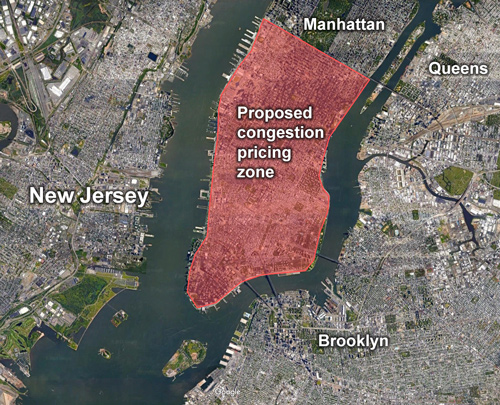April 5, 2019
On Sunday March 31, the New York State Legislature and Democratic Gov. Andrew Cuomo signed off on a $175 billion budget for fiscal year 2020. The plan included dedicated funding streams for the Metropolitan Transit Authority (MTA), to be supported by a variety of sources including a central business district tolling program, or congestion pricing.
This will be the first cordon pricing program of this scale to be implemented in the US. The charge will contribute toward an estimated $40 billion in needed repairs for the MTA. It is projected to raise $1 billion annually from fees to drivers entering the central business district below 60th street (see image below), and the revenue will be used to secure bonds up to $15 billion to fund MTA capital projects through 2024. The enacted budget creates a dedicated lockbox to ensure that 100% of the revenue will go to the MTA capital budget.
The charges, which are designed to reduce traffic in the busiest parts of Manhattan, will be assessed by electronic tolling devices at the edges of the central business district. According to the governor’s office, the charges will be variable and passenger vehicles will only be charged once per day. The Triborough Bridge and Tolling Authority (TBTA) will have authority to establish, operate, and maintain the central business district tolling program, and a six-member Traffic Mobility Review Board will be established by TBTA to advise on tolls, exemptions, and credits.

In 2007, the U.S. Department of Transportation under Secretary Mary Peters tried to give NYC, under Mayor Mike Bloomberg, $355 million in federal grant money in exchange for their adoption of cordon congestion pricing (see the USDOT-NYC memo of understanding here), but the idea fell apart when the Governor and state lawmakers failed to support it. This time around, the idea has gained support from a diverse range of stakeholders, including environmental groups, transit advocates, civic organizations, and business groups. For example, Uber has spent more than $2 millionlobbying for congestion pricing in New York City since 2015, despite the current lack of information about how the charges will affect their services.
The charges won’t be in place until after the 2020 legislative elections. Until then, the following factors still need to be determined.
How much will drivers pay? A congestion charge is a demand-side priceaimed at managing the flow of traffic during peak hours. A charge that is too low will not achieve the intended goal of reducing congestion on city streets, while a charge that is too high will create social equity concerns and fail to provide a revenue stream to support public transit improvements. In New York, the charge is projected to be lower on nights and weekends when demand is not as high.
The exact charge is yet to be determined by the TBTA-established panel, but some have estimated that it will run between $12 and $14 for car drivers and about $25 for truck drivers. Also unknown is how the charges would affect drivers entering Manhattan through already-tolled bridges and tunnels like the Henry Hudson Bridge or the Lincoln Tunnel, though those drivers would likely receive credits toward the congestion fee while those who have crossed the Brooklyn Bridge to head north on FDR Drive, a limited access highway, past 60thStreet would not be subject to the congestion charge.
Who will be exempt from the charges? Exemptions for a number of different types of drivers or trips have been discussed, including: New York City residents, those who are low income, those with disabilities, those who are driving to medical appointments, “essential” trips by city employees, and taxi or ride-hailing services. Applied too broadly, exemptions can limit the effectiveness of a congestion pricing program. Rather, New York City might consider exploring other programs, like subsidies on ride-hailing or paratransit services for those with disabilities, to meet citizens’ needs as it implements a comprehensive congestion pricing program.
London’s congestion charge, which was initially set at a flat £5 in 2003, exempted private for-hire vehicles like taxis and ridehailing services. The charge was initially effective at reducing congestion, but traffic has worsened despite the fee rising to £11.50 today. Citing for-hire vehicles’ contributions to congestion and declining air quality, last year Mayor Sadiq Khan announced that these services will no longer be exempt from the fee starting April 8, 2019.
How will the charge affect the city’s public transit system? The city will need to consider how it will meet the inevitable increase in demand for public transportation. Other cities have experienced near-immediate effects of congestion charges (on day one of its charge, London experienced a 25 percent drop in traffic below normal levels), and New York should plan for increased ridership on transit. In London, bus service was dramatically increasedin advance of the congestion charge’s implementation to allow for increased ridership.
The push for congestion pricing has coincided with the release of New York City Transit Authority president Andy Byford’s “Fast Forward” planto modernize transit in the city. Though the fees will not come close to the projected $40 billion in maintenance and modernization needs of the system, devoting the revenue generated by congestion pricing to improving transit was a major selling point by lawmakers in support of congestion pricing. Transit signaling and accessibility improvements have been suggested as priorities for system updates, but many of the specific details are yet to be determined.
Despite a number of unknowns, New York has – to some degree – passed the biggest hurdle in implementing congestion pricing by garnering broad support among state legislators and political leaders.
How the details of congestion pricing unfolds in the days to come is important, as other cities are beginning to look to New York’s precedentas a model to follow in implementing their own congestion pricing initiatives.




